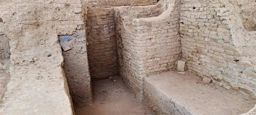FN Souza (front row, first from L) with other members of Progressive Artists Group.
Book Title: FN Souza: The Archetypal Artist
Author: Janeita Singh
Rajnish Wattas
It’s mostly the rebel who transforms the established canons of art in any era. He challenges the existing norms to pursue his own inner calling, notwithstanding the opposition and suffering that come along with the new unsettling vision. In the western painting, Impressionists like Claude Monet, Cubists like Pablo Picasso and Salvador Dali, the creator of Surrealism, among others, broke shackles of previous styles to carve out new visions.

by Janeita Singh.
Niyogi Books.
Pages 320. Rs 4,500
In architecture, too, Modernism — predominantly ushered in by Le Corbusier in Europe and Frank Lloyd Wright in America (the latter inspiring Howard Roark, the protagonist of the cult novel ‘Fountainhead’ by Ayn Rand) — initially faced opposition to the radical new ideas.
As the birth centenary of post-Independence India’s most controversial painter, Francisco Victor Newton de Souza, is commemorated, a renewed interest has been generated worldwide. A retrospective of his work — ‘Reminiscing Souza: An Iconoclastic Vision’ — is on display at Dhoomimal Gallery, Delhi, curated by renowned art historian Yashodara Dalmia.
At a Christie’s auction held last month, his work ‘The Lovers’ (1949), considered among the artist’s most important figurative paintings, set a new record by going for nearly Rs 40 crore. Previously, ‘Birth’ (1955), depicting his mistress posing naked while she was pregnant, set a world auction record in 2015, fetching around Rs 34 crore. But the value of artwork far transcends its commercial price.
Janeita Singh’s magisterial treatise on his work and life, titled ‘FN Souza: The Archetypal Artist’, is timely and epic in its research. The enfant terrible of modern Indian painting challenged the aesthetic and moral sensibilities of the art establishment at that time. “FN Souza has always been a discomfiting if adulated presence in Indian modernist art. Through his life, buyers were reluctant to collect or display his paintings, which disturb conventional norms of propriety and trouble social comfort by its transgression of taboos, bordering on the pornographic and the monstrous,” says Dalmia.
Souza was a born rebel. A Goan Catholic, he attended St Xavier’s College in Bombay, but was expelled in 1939 for drawing obscene graffiti in the toilets and later from the Sir JJ School of Art in 1945 for pulling down the Union Jack during a school ceremony. The fiery young artist soon co-founded the Bombay Progressive Artists Group (PAG), along with SH Raza, KH Ara, MF Husain, SK Bakre and HA Gade. “They saw the importance of looking back at India’s classical, artistic past and at the West for innovations in technique and style, to create a new language for modern art in India,” explains Nishad Avari.
The book is divided into five sections with a total of 21 essays — unpeeling the various palimpsests of Souza’s provocative art. Janeita sees his work as hugely courageous, liberating and pioneering for Indian womanhood. She brings to focus his core ideology that the so-called ‘obscenity’ is in the eye of the beholder and not in the human body, which itself is a work of God and a divine art form.
To reconstruct sources of Souza’s inspirations, Janeita draws upon Indian miniature paintings, primitivism and ancient treatises of Kamasutra and the philosophy of Carl Jung. Her comparison of Souza’s ‘Bathers’ (1946), with its ease of female figures at home with their bodies, completely devoid of self-consciousness, when contrasted with the Indian miniature paintings of Krishna and demure gopis and the nudes of the western classical art, usually depicting vulnerable, supine women, or the impressionist figures of Paul Cezanne and Henri Matisse, illustrates the point.
This highly erudite and definitive work on FN Souza, brought out in an elegantly published volume with high quality reproductions of the paintings, is a befitting tribute to the art and life of India’s pioneering modernist painter. In the end, he, like the proverbial tragic hero consumed by alcoholism and a life of a Lothario, died in 2002 in Mumbai, with a very small number of mourners to bid farewell. Alas, India did not value its own ‘Picasso’ when he was alive.
In a moving tribute, the legendary MF Husain said: “Souza was my mentor...
he is the most significant painter, almost a genius.”














